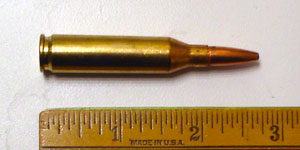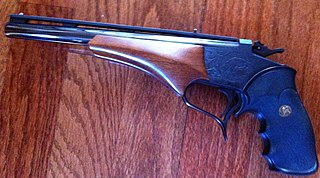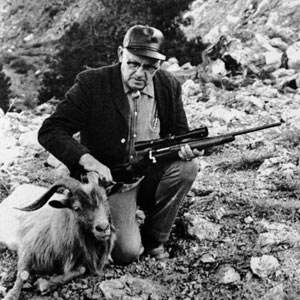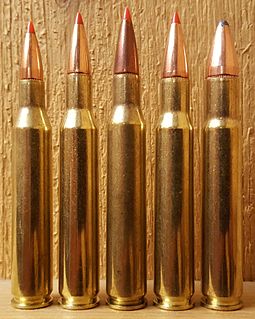Related Research Articles

The 223 Remington is a rifle cartridge, originally developed in 1957 as a commercial hunting bullet for varmint hunting. The first rifle chambered for it came out in 1963. It has continued to be a popular civilian small game hunting cartridge. Though it finds occasional use on medium game, this is not recommended and is illegal in at least ten U.S. states and the United Kingdom, where the .243 Winchester or similar cartridges are the smallest bore cartridges that are legal for hunting deer.
The .256 Winchester Magnum is a firearms cartridge developed by Winchester, and was produced by necking-down a .357 Magnum cartridge to .257 diameter. It was designed for shooting small game and varmints.

The .22 Hornet or 5.6×35mmR is a varminting, small-game hunting, survival and competition centerfire rifle cartridge commercially introduced in 1930. It is considerably more powerful than the rimfire .22 WMR and the .17 HMR, achieving higher velocity with a bullet twice the weight of the .17 HMR bullet. The Hornet also differs very significantly from these in that being a centerfire cartridge makes it reloadable, and thus much more versatile. It was the smallest commercially available .22 caliber centerfire cartridge until the introduction of the FN 5.7×28mm.
The .221 Remington Fireball, often simply referred to as .221 Fireball, is a centerfire cartridge created by Remington Arms Company in 1963 as a special round for use in their experimental single-shot bolt-action pistol, the XP-100. A shortened version of the .222 Remington, it is popular as a varmint and small predator round while also finding use among target shooters. It has application as both a pistol round and as a rifle round.

The .22 Remington Jet is a .22 in (5.6mm) American centerfire revolver and rifle cartridge.

A wildcat cartridge, often shortened to wildcat, is a custom cartridge for which ammunition and/or firearms are not mass-produced. These cartridges are often created in order to optimize a certain performance characteristic of an existing commercial cartridge.

The .243 Winchester (6.2×52mm) is a popular sporting rifle cartridge. Developed as a versatile short action cartridge to hunt both medium game and small game alike, it "took whitetail hunting by storm" when introduced in 1955, and remains one of the most popular whitetail deer cartridges. It is also commonly used for harvesting blacktail deer, pronghorns and mule deer with heavier rounds, and is equally suited to varmint hunting with lighter rounds. The .243 is based on a necked down .308 Winchester, introduced only three years earlier. Expanding monolithic copper bullets of approximately 80 to 85 grains or traditional lead rounds of 90 to 105 grains with controlled expansion designs are best suited for hunting medium game, while lighter rounds are intended for varmints.
Thompson/Center Arms was an American firearms company based in Springfield, Massachusetts. The company was best known for its line of interchangeable-barrel, single-shot pistols and rifles. Thompson/Center also manufactures muzzle-loading rifles and was credited with creating the resurgence of their use in the 1970s.

The .30-30 Winchester/.30 Winchester Center Fire cartridge was first marketed in 1895 for the Winchester Model 1894 lever-action rifle. The .30-30 (thirty-thirty), as it is most commonly known, and the .25-35 were offered that year as the USA's first small-bore sporting rifle cartridges designed for smokeless powder. Sixty years after its introduction, in 1955, it was surpassed by the smaller bore .243 Winchester cartridge with more powerful and accurate ballistics yet similar recoil, but the .30-.30 Winchester remains in widespread use even today.

The Thompson/Center Contender is a break-action single-shot pistol or rifle that was introduced in 1967 by Thompson/Center Arms. It can be chambered in cartridges from .22 Long Rifle to .45-70 Government.

The 8mm Remington Magnum belted rifle cartridge was introduced by Remington Arms Company in 1978 as a new chambering for the model 700 BDL rifle. The 8mm Remington Magnum's parent case is the .375 H&H Magnum. It is a very long and powerful cartridge that cannot be used in standard length actions, such as those that accommodate the .30-06 Springfield.
The .260 Remington cartridge was introduced by Remington in 1997. Many wildcat cartridges based on the .308 Winchester case had existed for years before Remington standardized this round.

The .257 Roberts, also known as .257 Bob, is a medium-powered .25 caliber cartridge. It has been described as the best compromise between the low recoil and flat trajectory of smaller calibers such as the 5 mm (.22") and 6 mm, and the higher energy but harder recoil of larger popular hunting calibers, such as the 7 mm family and the popular .30-06.

Parker Otto Ackley was an American gunsmith, barrel maker, author, columnist, and wildcat cartridge developer. The Ackley Improved family of wildcat cartridges are designed to be easily made by rechambering existing firearms, and fireforming the ammunition to decrease body taper and increase shoulder angle, resulting in a higher case capacity. Ackley improved not only standard cartridges, but also other popular wildcats, and was the first to create a .17 caliber (4.5 mm) centerfire cartridge.
The 6×45mm is a rimless, bottlenecked cartridge based on the .223 Remington or 5.56 NATO cartridge necked up to .243 (6mm). The cartridge is also known as the 6mm-223 Remington or 6mm/223.

.30-06 Springfield wildcat cartridges are cartridges developed from a 30-06 Springfield "parent cartridge" through narrowing or widening the cartridge neck to fit a smaller or larger bullet in an attempt to improve performance in specific areas. Such wildcat cartridges are not standardized with recognized small arms standardization bodies like the SAAMI and the CIP.

Varmint rifle is an American English term for a small-caliber precision firearm or high-powered airgun primarily used for both varmint hunting and pest control. These tasks include killing three types of pests or nuisance animals that spread diseases or destroy crops or livestock:
The 7mm BR Remington, commonly called the 7mm BR or the 7mm Benchrest Remington in long form, was a cartridge developed by Remington for the Remington XP-100 single-shot bolt-action handgun. The cartridge was developed for the Unlimited Class in the sport of Metallic silhouette shooting. Later it was introduced in the Remington Model XB-40 single-shot bolt-action rifle, which was specifically designed for the benchrest shooting community.
The .277 Wolverine (6.8×39mm) is a wildcat cartridge. It is a multi-purpose mid-power cartridge with increased ballistic performance over the AR-15's traditional .223 Remington cartridge requiring only a new barrel to upgrade/convert any 5.56-based firearm to .277 Wolverine.
References
- 1 2 Bryce M. Towsley (May 1997). "Case-Forming Top Contender Hunting Loads". Performance Shooter.
- ↑ "Results from the 2007 Internationals, Big Bore".